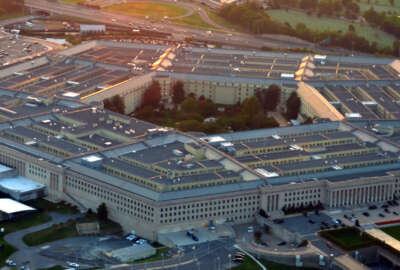
Pentagon lights up its first Wi-Fi network through $36 million in IT savings
DoD now has a fully-functional Wi-Fi network throughout much of the building, something that was unimaginable to the Pentagon’s own IT experts as recently as a...
It may or may not have been the intent of the Pentagon’s World War II-era designers, but the mostly concrete structure of world’s most famous five-sided building makes it a black hole for radio frequencies, including cell signals, making it hard to achieve the kind of mobile work and communication that’s commonplace in most 21st century offices.
That’s changed in just the last couple months. DoD now has a fully-functional Wi-Fi network throughout much of the building, something that was unimaginable to the Pentagon’s own IT experts as recently as a few years ago because of cybersecurity concerns. The current implementation gives DoD employees secure wireless access to the military’s NIPRNet and also lets guests access the public internet.
For end users, the Wi-Fi project is one of the earliest and most visible results of DoD’s decision to consolidate its IT services under a single organization known as the Joint Service Provider, the shared services organization that’s operationally controlled by the Defense Information Systems Agency.
Brig. Gen. Brian Dravis, JSP’s director, said the bill for the Wi-Fi project was paid entirely out of part of the efficiencies the department gained by merging several somewhat ad-hoc organizations that used to run IT systems in most of the building, the largest of which were the Army’s Information Technology Agency and the Enterprise Information Technology Services Directorate, part of the DoD’s Washington Headquarters Services.
“The deputy secretary of Defense gave us some very specific savings targets that we had to meet in fiscal 2016, and several of our senior leaders told me it was a fantasy; we’d never do it. They were right: instead, we doubled it,” Dravis said Thursday, adding the consolidation yielded $30.7 million in savings during the prior year. “I think we’ve firmly validated the concept of joint IT and cyber defense within the Pentagon.”
The Pentagon received major IT upgrades as part of the physical plant modernization the department undertook during major building renovation over the past two decades known as “PenRen.” Thousands of miles of new cabling were installed, data centers became somewhat more consolidated, but each of the military services and other building tenants retained operational and administrative control over the IT infrastructure that served them.
That will begin to change over the next 10 months, when JSP will be absorbed into the Defense Information Systems Agency and take on responsibilities for most Pentagon IT functions, including the management of about 500 IT contracts and about $1 billion in IT infrastructure.
“That means we’re going to inherit the responsibility to modernize all of this,” Dravis said. “And to us, that means breaking the cycle of just taking out a legacy box and replacing it with a new box that does what the old one did.”
He said the JSP would work with the General Services Administration on a forthcoming request for proposals for broader network modernization. Within the next year, DISA’s main contracting outfit at Scott Air Force Base will take over for the Army and WHS offices that handled most Pentagon IT contracting until now, and by 2018 the JSP will be fully housed within DISA and serve as a “one-stop shop” for vendors looking for IT work within the Pentagon.
Future top priorities for JSP contracts will include an emphasis on automating and virtualizing the building’s IT infrastructure and making its service-specific networks operate more jointly, Dravis said.
“We’re really focusing on compliance with all the directives that are already out there. We don’t have to do anything new; we’ve just gotta comply,” he said. “For example, we’ve put folks on notice that we’re no longer going to allow hoteling of applications. That’s a culture change for a lot of people in the Pentagon and it’s driving a lot of activity by our tenant organizations who’ve gotten accustomed to being able to hotel their own servers and applications and services in the building. It’s going to force some tough decisions for our partnered organizations.”
Return to the DoD Reporter’s Notebook
Copyright © 2024 Federal News Network. All rights reserved. This website is not intended for users located within the European Economic Area.
Jared Serbu is deputy editor of Federal News Network and reports on the Defense Department’s contracting, legislative, workforce and IT issues.
Follow @jserbuWFED





